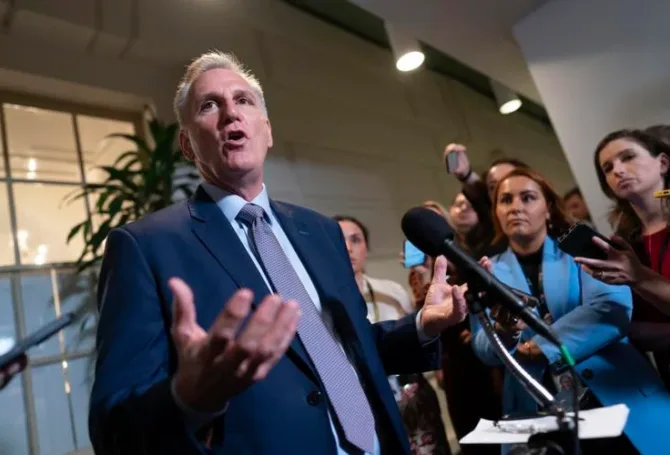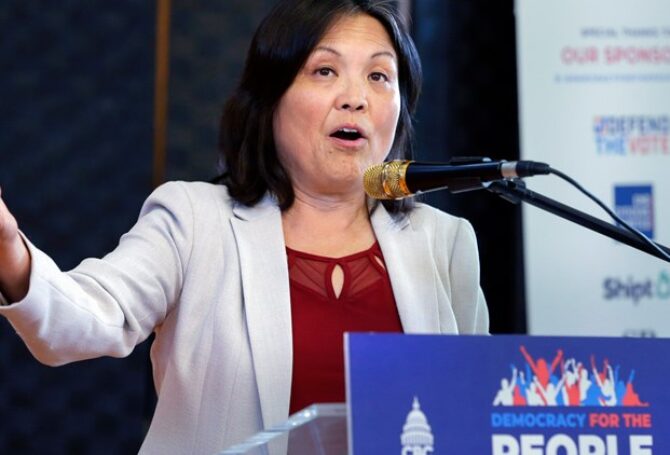
House Conservatives Tie Up Spending Measures to Secure Spending Cuts
With a partial federal government shutdown just days away, partisan politics has more traction in the Capitol than a plausible and passable plan to prevent a shutdown. It’s not that bipartisan talks have stalled; they really haven’t begun.
Amid the posturing on a continuing resolution to keep government running, House Republicans are launching an impeachment inquiry into President Biden’s alleged corruption that occurred while he was Vice President.
 Capitol Hill also was abuzz following a relaxed Senate dress code that allows Democratic Pennsylvania Senator John Fetterman to wear his trademark hoody and shorts. Senator Susan Collins, R-Maine, suggested she might show up on the Senate floor in a bikini.
Capitol Hill also was abuzz following a relaxed Senate dress code that allows Democratic Pennsylvania Senator John Fetterman to wear his trademark hoody and shorts. Senator Susan Collins, R-Maine, suggested she might show up on the Senate floor in a bikini.
A mixture of issues has created the financial stew facing Congress. Right-wing House Republicans are holding out for a one-month continuing resolution with more money for border security but no additional money for Ukrainian aid. It isn’t clear there are enough Republican votes to pass that in the House. At least five House conservatives have said they will hold their ground even if it forces a government shutdown. The GOP only has a four-member majority in the House. They have failed twice to get a defense appropriations bill to the House floor.
Conservatives want deeper cuts in FY 2024 spending bills than would be allowed under the debt ceiling deal struck by Biden and House Speaker Kevin McCarthy. Conservative House members also have added culture war provisions to appropriations bogging down their progress.
House GOP Budget Bill
Months after the April 15 deadline, the GOP-controlled House has started work on the FY 2024 budget, even though Senate Budget Chair Sheldon Whitehouse, D-Rhode Island, has given up trying to negotiate a budget for the next fiscal year.
 House Budget Chair Jodey Arrington, R-Texas, unveiled the Republican budget blueprint that “promises to bring the federal budget into balance over a decade through steep cuts to discretionary spending, new restrictions on the social safety net and rosy assumptions of consistently strong economic growth”, according to Roll Call. Arrington sounded hopeful the 218 House Republicans would back the austere budget. Democrats are lined up against it.
House Budget Chair Jodey Arrington, R-Texas, unveiled the Republican budget blueprint that “promises to bring the federal budget into balance over a decade through steep cuts to discretionary spending, new restrictions on the social safety net and rosy assumptions of consistently strong economic growth”, according to Roll Call. Arrington sounded hopeful the 218 House Republicans would back the austere budget. Democrats are lined up against it.
The package Arrington is pushing would slash projected deficits in discretionary spending by $16.3 trillion over a decade, resulting in a $130 billion surplus after 10 years. A $1 trillion savings is projected by cutting in half “improper payments” by government agencies.
During the same decade, mandatory spending – such as Medicare, Medicaid, cash assistance and food stamps – would be reduced by $8.7 trillion. Arrington’s blueprint doesn’t specifically mention Medicare cuts but counts $400 billion in savings from cost-cutting measures affecting Medicare providers. The plan seeks to save $800 billion by reducing Medicaid reimbursement to states. The blueprint also calls for creation of a commission to study entitlements.
A major tenet of the budget blueprint is $3 trillion in increased federal revenue, all of which would go to deficit reduction. That growth would occur, the blueprint says, through policy changes that include deregulation, trade expansion, domestic energy production and additional tax cuts. Another $3 trillion in savings would come from lower interest payments on the national debt.
It’s unclear whether the budget resolution can even pass in the GOP-controlled House, especially with no chance in the Democratically controlled Senate. Even if it somehow passed, it is too late to influence FY 2024 appropriations bills, which include congressional spending earmarks, that are pending for floor votes in the House and Senate.
Despite a doubtful prospect of success, Arrington believes the exercise could placate House conservatives enough to win their support for a continuing resolution before the new fiscal year begins October 1. That seems unlikely,too.
 Looming Medicaid Hospital Funding Cuts
Looming Medicaid Hospital Funding Cuts
Hospital officials, including at OHSU, are appealing to Congress to avert an $8 billion cut in Medicaid reimbursement to hospitals that serve a disproportionate share of uninsured and low-income patients. Additional $8 billion per year cuts are scheduled between now and FY 2027.
The reduction, due to take effect October 1, was mandated by the Affordable Care Act in anticipation the number of uninsured Americans would decline. They haven’t.
“Not only does Medicaid disproportionate share hospital (DSH) funding ensure access to care for millions of people, it enables our hospitals to provide essential services to their communities, including top-level trauma, burn and neonatal intensive care. The need for funding is even greater now, as hospital expenses per patient have increased significantly since the pandemic,” according to America’s Essential Hospitals.
The pending cuts have prompted bipartisan concerns in Congress. Twenty senators, led by Senators Bob Casey, D-Pennsylvania, and James Lankford, R-Oklahoma, said in a letter to Senate leaders, “It is essential we continue to protect those who have come to rely on the services provided by Medicaid DSH hospitals. We ask you to act as soon as possible to address the Medicaid DSH cuts to ensure our nation’s hospitals can continue to care for every community.”




